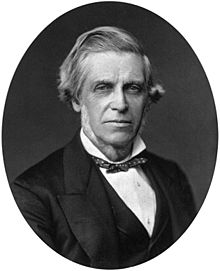Sir William Bowman, 1st Baronet facts for kids
Quick facts for kids
Sir William Bowman, Bt
|
|
|---|---|

Sir William Bowman, 1st Baronet
|
|
| Born | 20 July 1816 Nantwich, Cheshire, England
|
| Died | 29 March 1892 (aged 75) Holmbury St Mary, Surrey
|
| Nationality | English |
| Known for | Bowman's Capsule Bowman's glands Bowman's layer Microscopes |
| Awards | Royal Medal (1842) |
| Scientific career | |
| Fields | Surgeon Histologist Anatomist |
Sir William Bowman (born July 20, 1816 – died March 29, 1892) was an English doctor. He was a surgeon, a histologist (someone who studies tiny body tissues), and an anatomist (someone who studies the body's structure). He is famous for using microscopes to learn about human organs. He also had a very successful career as an ophthalmologist, which is an eye doctor.
Contents
Early Life and Training
William Bowman was born in Nantwich, a town in Cheshire, England. He was the third son of a banker. His father also enjoyed studying plants and rocks. From 1826, William went to Hazelwood School near Birmingham.
A small accident with gunpowder when he was a child made him interested in medicine. In 1832, he started training with a surgeon named Joseph Hodgson at Birmingham General Hospital. In 1837, he moved to King's College London to continue his training. There, he worked as a prosector (someone who prepares bodies for study) with Robert Bentley Todd, a professor of physiology (the study of how living things work).
Amazing Discoveries
William Bowman's early work focused on how muscles are built. Because of this important research, he became a member of the Royal Society in 1841. This was a big honor!
When he was only 25, he found a key part of the nephron, which is the tiny unit in your kidney that filters blood. This part is now called the Bowman's capsule. He shared his discovery in 1842 in a paper called "On the Structure and Use of the Malpighian Bodies of the Kidney". For this, he received the Royal Medal.
He worked closely with Robert Bentley Todd. Together, they wrote several books, including "Physiological Anatomy and Physiology of Man" (published between 1843 and 1856). These books showed their research using microscopes. They connected tiny details of the body's structure to how the body works. Their use of microscopes changed how people studied anatomy and physiology forever.
Besides the Bowman's capsule, other parts of the body are named after him:
- Bowman's glands – found in the part of your nose that helps you smell.
- Bowman's layer – a thin layer in the front part of your cornea (the clear outer part of your eye).
Career as an Eye Doctor
After finishing his surgical training in 1844, Bowman became an eye doctor. He worked at the Royal London Ophthalmic Hospital, which is now known as Moorfields Eye Hospital. He was one of the first doctors to use the ophthalmoscope. This tool was invented by Hermann von Helmholtz in 1851 and helps doctors look inside the eye.
From 1848 to 1855, he also taught at King's College. In 1880, he started the 'Ophthalmological Society'. This group later became the Royal College of Ophthalmologists, which is a very important organization for eye doctors.
Later Life and Honors
In 1870, William Bowman asked an architect named Philip Webb to rebuild his house, Joldwynds, in Holmbury St Mary, Surrey. The work was finished in 1874.
In 1884, Queen Victoria made him a baronet. This means he received a special title, "Sir," that could be passed down in his family. He passed away at his home, Joldwynds, on March 29, 1892. He is buried in the churchyard nearby. There is also a memorial to him in St James's Church, Piccadilly in London.
Family
On December 28, 1842, William Bowman married Harriet Paget. They had seven children together. Harriet passed away in 1900. His oldest son, Sir Paget Bowman, inherited his title.
Images for kids


